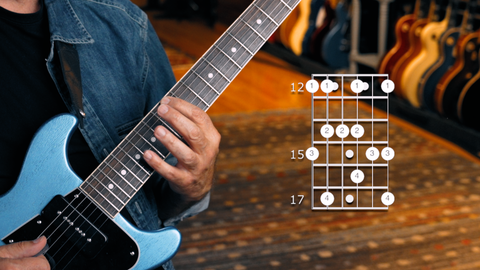
My Definitive Scales Course.
What Is The Scale Matrix?
I built The Scale Matrix over many months as a 3.5+ hour, complete, connected guide to guitar scales. We start where most players live: major and minor pentatonics, and make them complete by mapping roots in every position and showing how to connect shapes across the entire neck.
The goal is simple: turn five boxes into one map so you can play in any key, anywhere, without getting lost.
From there, we add the sounds that move your playing forward: major‑scale modes, hexatonic options, melodic and harmonic minor, plus diminished, augmented, and whole tone.
I show what each sounds like, where it sits, and when to use it—so you can pick the right sound for the chord, solo over changes without guessing, and add real color to your lines. Clear neck diagrams and musical examples make it practical from day one.
Table of contents

1. Introduction
Welcome to The Scale Matrix: Your complete system for mastering the fretboard. Follow along with interactive lessons and download the materials for each section to practice offline.
2. Major and Minor Pentatonics
Learn the five pentatonic shapes, both major and minor across the entire neck. See how they're built, what makes them different, and how they connect to each other.
3. Finding Pentatonic Roots
This chapter shows you how to find root notes in major and minor pentatonic scales. We start with Major pentatonic and work from there.
4. Connecting Pentatonic Shapes
In this lesson, I show you how to use extended Pentatonic shapes to move up the neck. We start with first Minor pentatonic position and build from there.
5. Developing Pentatonic Sequences
Create interesting sequences with pentatonic scales using repeated fingering patterns, odd note groupings and shifting positions.
6. The Blues Scale
An introduction to the Blues Scale — The Pentatonic Scale with one extra note added. Learn where this "blue note" sits in each position and how it changes the sound of your playing.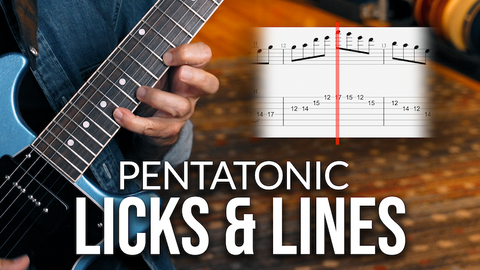
7. Pentatonic Licks
Pentatonic licks and patterns that connect different positions across the neck. Learn how to move smoothly between shapes so you can play freely over the entire fretboard instead of getting stuck in boxes.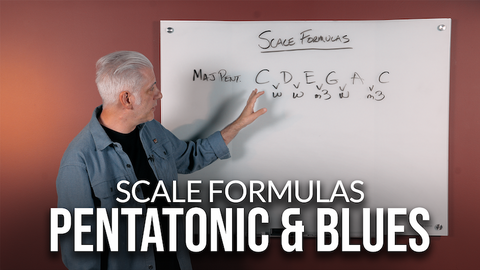
8. Pentatonic and Blues Scale Formulas
An in-depth look at Major and Minor Pentatonic Scales, plus the Blues Scale. You'll understand how each one is constructed, when to use them, and how they relate to each other.
9. The Hexatonic Scale
An introduction to the Hexatonic Scale and its five positions up the neck. This six-note scale adds more color than Pentatonics while staying simpler than full seven-note scales, giving you more options without extra complexity.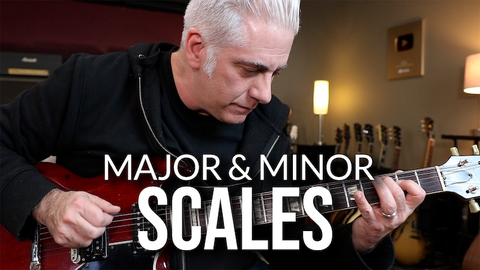
10. Major and Minor Scales
Major and Minor scales across the five positions up the neck. Learn how to play every available note in each position for both scales, giving you complete coverage of the fretboard.
11. Modes of the Major Scale
In this lesson we examine the modes of the Major Scale inside of each position. You'll learn all seven mode patterns. Ionian, Dorian, Phrygian, Lydian, Mixolydian, Aeolian, and Locrian and see how each one creates its own unique sound from the same set of notes.
12. Modes of Major Scale: Theory
An in-depth look at the modes of the Major Scale and how to use them in your lines. You'll learn how each mode. From bright Lydian to dark Phrygian creates its own distinct sound, even though they share the same notes.
13. Modes of Melodic Minor
Demonstrating Melodic Minor and its seven modes up the neck, plus how to use them in context. You'll learn these colorful sounds, including Lydian Dominant and Altered and see exactly when and where to apply them in your playing.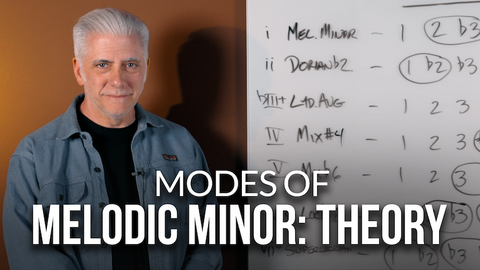
14. Modes of Melodic Minor: Theory
In this exercise we explore the modes of Melodic Minor with an in-depth tutorial. You'll work through each of the seven modes systematically, understanding their unique intervals and hearing how each one colors your playing differently.
15. Modes of Harmonic Minor
Demonstrating Harmonic Minor and its seven modes up the neck, plus how to use them in context. You'll learn these distinctive sounds, including Phrygian Dominant, the exotic-sounding fifth mode.
16. Modes of Harmonic Minor: Theory
We now take a look at the modes of Harmonic Minor with a whiteboard tutorial. I'll break down each of the seven modes visually, showing you the formulas and intervals that give each one its distinctive character.
17. Scale Formulas
An in-depth explanation of scale formulas for Major, Melodic Minor, Harmonic Minor, Diminished, Augmented, and Whole Tone scales. You'll understand the exact intervals that build each scale, making it easier to construct and transpose them anywhere on the neck.
18. Diminished Scale
Introducing the Diminished Scale and how to use it in context, alternating half and whole steps. You'll learn both forms of this symmetrical scale and discover where it works best over diminished and dominant chords.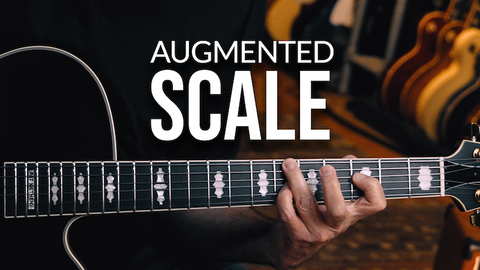
19. Augmented Scale
Introducing the Augmented Scale and how to use it in context. This symmetrical scale creates unusual sounds perfect for rock and other styles, though the fingerings take some practice to master.
20. Whole-Tone Scale
Introducing the Whole-Tone Scale and how to use it in context. This six-note scale creates a floating, dreamlike sound that opens up new possibilities for improvisation and expands your playing style.
21. This Course In Context
A recap of The Scale Matrix, understanding the scales and what to take away from this course. We'll review how all these scales connect, from Pentatonics to Symmetric Scales, giving you a complete system for navigating the fretboard.Frequently asked questions
It's a one-time purchase.
If you know basic pentatonic shapes and can play simple licks, you’re ready. We start there and build step by step.
You will receive an email. Simply click the link, choose a password and start learning!
Yes. You’ll learn to apply Pentatonics, Blues, modes of the Major, Melodic and Harmonic Minor scales as well as Symmetrical scales over real chord types and progressions.
Streaming video with lifetime access. Desktop, tablet, and mobile friendly.
5‑day money‑back guarantee. If it’s not for you, contact support within 5 days of purchase—no questions asked.
Early Access is $79 for 7 days. After that, the price increases toward the regular $159.







